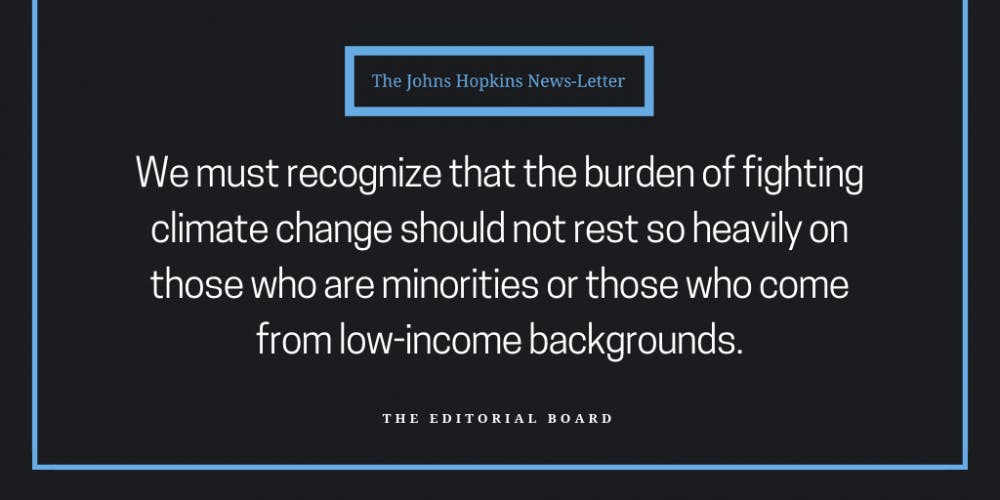The first week of Black History Month is coming to a close. That same week has been a period of extreme, fluctuating weather in Baltimore: after days of snow and temperatures as low as six degrees Fahrenheit, we enjoyed sunny 70-degree weather on Tuesday.
It was also a week of environmental activism in our city. While a rally for the Clean Air Act in Baltimore was cancelled last Wednesday because of the cold, the act passed on Jan. 31 and passed a second round of voting on Feb. 4. The act aims to reduce emissions from incinerator plants Wheelabrator Baltimore and Curtis Bay Energy, which Baltimore residents blame for deteriorating the city’s air quality.
To some, the act’s passing and the commencement of Black History Month may seem disparate and unrelated. What we see, however, is a reminder of what is often overlooked: the close connection between racism and climate change. We may not realize it, but more often than not, we cannot fight against one – or perpetuate one – without fighting against or perpetuating the other. In environmental racism, communities of color are disproportionately affected by environmental risks such as pollutants, emissions and natural disasters.
Although people of color and those who live in low-income communities generally have the lowest carbon footprint, they often live in areas with the worst air quality and are most susceptible to flooding or other weather hazards. Meanwhile, those of us who have done the most to aggravate climate change – higher-income individuals, mega-corporations and business magnates – have the resources to avoid the consequences of our actions.
Those consequences have begun to manifest – not just in developing countries, but here in our own city. It has been over 50 years since Congress banned racial redlining, or discriminatory housing practices designed to prevent black residents from living in more affluent neighborhoods. Yet its legacy continues today. In Baltimore, African Americans are concentrated in lower-income neighborhoods with crumbling infrastructure. When climate change-related disaster strikes – floods, deadly heat waves or droughts – their lack of access to necessities like stable housing, clean water and emergency assistance means that they will be worse off than those in middle-class white neighborhoods.
Lower-income minority residents are also likelier than wealthier residents to live near sources of significant pollution, including landfills, power plants and incinerator plants like Curtis Bay in Baltimore. A report by the National Association for the Advancement of Colored People (NAACP) from 2012 shows that over 78 percent of all African Americans live within 30 miles of a coal-fired power plant.
The fact that Baltimore is one of America’s 10 most polluted metropolitan areas in terms of air quality means that minority residents in low-income communities are at an even greater disadvantage. In 2013, Baltimore had the highest rate of deaths from pollution among U.S. cities, with nearly 130 deaths per 100,000 people and a total of 800 deaths a year. That year, over a third of Baltimore children had asthma. Since then, these trends have been slow to change.
Often, people in positions of privilege overlook the role of minorities and those in low-income communities in fighting against climate change. Engaging in sustainable, environmentally conscious consumerism can be expensive, and environmental advocacy groups are also predominantly made up of white, upper-middle class activists. Yet we cannot forget how throughout history, minorities have been vocal advocates against environmental degradation. A recent Pew Research Center survey also indicated that 80 percent of minority residents in the U.S. acknowledge that the earth has been warming and expressed concern about climate change. On the other hand, only 60 percent of white Americans shared the same concern.
In particular, indigenous people in this country have been at the forefront of environmental activism long before affluent white people formed environmental organizations. They have protested the creation of the Dakota Access oil pipeline for fear that it would pollute sacred waterways in their communities.
Moreover, we must recognize that the burden of fighting climate change should not rest so heavily on those who are minorities or those who come from low-income backgrounds. Instead, that burden falls on our government and the corporations who have made our economy unsustainable. It falls on people who prioritize the profit of businesses over the longevity of our planet and the livelihoods of vulnerable communities. These are the people who are most responsible for the damage our environment suffers.
In the end, everyone has a role to play, and Hopkins is not exempt from this burden. As a wealthy, internationally known university with a world-class public health program, our University has the ability to be a leader and make a significant positive impact in combating climate change. Hopkins students have already made strides through sustained activism. Refuel Our Future has campaigned tirelessly for the University to fully divest its endowment from fossil fuel companies. In response, the University has divested from thermal coal, but it needs to do more.
The fight against climate change is the fight against environmental racism. As temperatures drop dramatically again in the coming days and as Black History Month unfolds, we must keep that in mind and hold our institutions, local and national, accountable.





